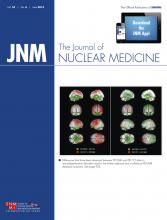TO THE EDITOR: Glaser et al. recently described the labeling of 18F-ZHER2:2891-Cys-NOTA-(COOH)2-AlF (18F-12) (1) and compared it in vivo to the biodistribution of that Affibody (Affibody AB) with 18F attached to carbon and silicon, as well as an 111In-DOTA-Affibody. They reported that the Al18F-labeled Affibody had a similar biodistribution to the 111In-Affibody, as previously noted by Heskamp et al. (2), and also observed that the Al18F-labeled Affibody had high uptake and retention in the kidney (∼80 percentage injected dose [%ID], like the 111In-Affibody). This is presumably because the small-sized Affibody is eliminated through the kidneys, where it is rapidly catabolized, with the resulting Al18F complex residualized in the renal tubules in the same manner as the 111In-DOTA complex (3). In contrast, when the carbon- and silicon-labeled Affibody molecules are metabolized in the kidney, the 18F-labeled metabolites are eliminated from the kidney cells, greatly reducing renal uptake. Although this clearly serves as an advantage for this product, much like differences between radioiodinated and radiometal-labeled antibody fragments, it is important to emphasize that renal uptake of the Al18F-Affibody product is a property of the Affibody targeting agent and not the Al18F complex. Previous studies with our pretargeting peptide (4) and the Al18F-NOTA-pegylated arginine-glycine-aspartic acid dimer (PRGD2) peptide (5) both showed excellent renal clearance in the mouse models, and the Al18F-NOTA-PRGD2 peptide also had good renal clearance in humans (6). It should also be noted that the 18F-Affibody labeled through a carbon atom had high hepatobiliary clearance (40–50 %ID in the intestines), whereas the Al18F-labeled Affibody had low uptake in the intestines. The high hepatobiliary accretion might be considered at least as undesirable as the high renal retention, depending on the use of the agent.
Glaser et al. also reported a 2-fold lower labeling yield for their Al18F-Affibody than the Al18F-labeling yield of a similar Affibody bearing the same NOTA ligand (11% vs. 21%), and this despite the fact that Heskamp et al. used a lower amount of the Affibody (2). Although we cannot discount the possibility that slight differences in the Affibody structure could have influenced the yields, we strongly suspect the yield differences are attributable to the lack of a co-solvent in the labeling procedure used by Glaser et al. Indeed, we have shown that the use of a co-solvent generally improves yields 2-fold (7).
Thus, we believe it is important when comparing labeling technologies to attempt to optimize or normalize each procedure, or if not empirically assessed, to state the conditions that might have affected yields when this information has been published previously. Second, whereas the nonresidualizing 18F-linkage used by Glaser et al. provided lower renal uptake, there likely are other situations, such as in target cells with a more rapid metabolism, in which a residualizing form of 18F afforded by the AlF method would be preferred (8).
DISCLOSURE
The Al18F project was supported in part by the National Center for Research Resources and the National Institute of Biomedical Imaging and Bioengineering of the National Institutes of Health through grant 5-R44-RR-028018-03. Drs. Goldenberg, Sharkey, and McBride are employed by and have stock in Immunomedics, Inc. Drs. Goldenberg and McBride are inventors of 10 U.S. patents issued on Al18F technology. No other potential conflict of interest relevant to this letter was reported.
Footnotes
Published online Apr. 24, 2014.
- © 2014 by the Society of Nuclear Medicine and Molecular Imaging, Inc.







